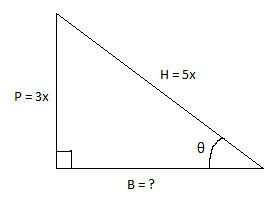
Find the value of $\sin \left( 2{{\sin }^{-1}}\dfrac{3}{5} \right)$ .
Answer
559.5k+ views
Hint: In a right-angled triangle with length of the side opposite to angle θ as perpendicular (P), base (B) and hypotenuse (H):
$\sin \theta =\dfrac{P}{H},\cos \theta =\dfrac{B}{H},\tan \theta =\dfrac{P}{B}$
${{P}^{2}}+{{B}^{2}}={{H}^{2}}$ (Pythagoras Theorem)
sin 2θ = 2 sin θ cos θ.
If sin θ = x, then we say ${{\sin }^{-1}}x=\theta $ .
$\sin ({{\sin }^{-1}}x)=x$ .
Complete step-by-step answer:
Let's say that ${{\sin }^{-1}}\dfrac{3}{5}=\theta $ .
∴ By the definition of inverse trigonometric functions, $\sin \theta =\dfrac{3}{5}$ .
And, by the definition of trigonometric ratios, $\sin \theta =\dfrac{P}{H}$ and $\cos \theta =\dfrac{B}{H}$ .
∴ P = 3x and H = 5x.
It can be represented using a right-angled triangle as follows:

Using the Pythagoras' Theorem:
$B=\sqrt{{{H}^{2}}-{{P}^{2}}}=\sqrt{{{(5x)}^{2}}-{{(3x)}^{2}}}=\sqrt{25{{x}^{2}}-9{{x}^{2}}}=\sqrt{16{{x}^{2}}}=4x$ .
And thus, $\cos \theta =\dfrac{B}{H}=\dfrac{4x}{5x}=\dfrac{4}{5}$ .
Now, using the identity sin 2θ = 2 sin θ cos θ, and substituting the values of $\sin \theta =\dfrac{3}{5}$ and $\cos \theta =\dfrac{4}{5}$ from above, we will get:
$\sin \left( 2{{\sin }^{-1}}\dfrac{3}{5} \right)=2\left( \dfrac{3}{5} \right)\left( \dfrac{4}{5} \right)$
On multiplying the terms on the Right-Hand Side of the equation together, we get:
⇒ $\sin \left( 2{{\sin }^{-1}}\dfrac{3}{5} \right)=\dfrac{24}{25}$ .
Hence, the value of $\sin \left( 2{{\sin }^{-1}}\dfrac{3}{5} \right)$ is $\dfrac{24}{25}$
Note: The inverse trigonometric functions, ${{\sin }^{-1}},{{\cos }^{-1}},{{\tan }^{-1}}$ ... etc. represent the value of an angle.
The inverse trigonometric functions, ${{\sin }^{-1}},{{\cos }^{-1}},{{\tan }^{-1}}$ ... etc. are also written as arcsin, arccos, arctan ... etc.
If one trigonometric ratio is known, we can use Pythagoras' Theorem and calculate the values of all other trigonometric ratios.
${{\sin }^{-1}}\dfrac{3}{5}=36.87{}^\circ $ .
$\sin \theta =\dfrac{P}{H},\cos \theta =\dfrac{B}{H},\tan \theta =\dfrac{P}{B}$
${{P}^{2}}+{{B}^{2}}={{H}^{2}}$ (Pythagoras Theorem)
sin 2θ = 2 sin θ cos θ.
If sin θ = x, then we say ${{\sin }^{-1}}x=\theta $ .
$\sin ({{\sin }^{-1}}x)=x$ .
Complete step-by-step answer:
Let's say that ${{\sin }^{-1}}\dfrac{3}{5}=\theta $ .
∴ By the definition of inverse trigonometric functions, $\sin \theta =\dfrac{3}{5}$ .
And, by the definition of trigonometric ratios, $\sin \theta =\dfrac{P}{H}$ and $\cos \theta =\dfrac{B}{H}$ .
∴ P = 3x and H = 5x.
It can be represented using a right-angled triangle as follows:

Using the Pythagoras' Theorem:
$B=\sqrt{{{H}^{2}}-{{P}^{2}}}=\sqrt{{{(5x)}^{2}}-{{(3x)}^{2}}}=\sqrt{25{{x}^{2}}-9{{x}^{2}}}=\sqrt{16{{x}^{2}}}=4x$ .
And thus, $\cos \theta =\dfrac{B}{H}=\dfrac{4x}{5x}=\dfrac{4}{5}$ .
Now, using the identity sin 2θ = 2 sin θ cos θ, and substituting the values of $\sin \theta =\dfrac{3}{5}$ and $\cos \theta =\dfrac{4}{5}$ from above, we will get:
$\sin \left( 2{{\sin }^{-1}}\dfrac{3}{5} \right)=2\left( \dfrac{3}{5} \right)\left( \dfrac{4}{5} \right)$
On multiplying the terms on the Right-Hand Side of the equation together, we get:
⇒ $\sin \left( 2{{\sin }^{-1}}\dfrac{3}{5} \right)=\dfrac{24}{25}$ .
Hence, the value of $\sin \left( 2{{\sin }^{-1}}\dfrac{3}{5} \right)$ is $\dfrac{24}{25}$
Note: The inverse trigonometric functions, ${{\sin }^{-1}},{{\cos }^{-1}},{{\tan }^{-1}}$ ... etc. represent the value of an angle.
The inverse trigonometric functions, ${{\sin }^{-1}},{{\cos }^{-1}},{{\tan }^{-1}}$ ... etc. are also written as arcsin, arccos, arctan ... etc.
If one trigonometric ratio is known, we can use Pythagoras' Theorem and calculate the values of all other trigonometric ratios.
${{\sin }^{-1}}\dfrac{3}{5}=36.87{}^\circ $ .
Recently Updated Pages
Master Class 11 Economics: Engaging Questions & Answers for Success

Master Class 11 English: Engaging Questions & Answers for Success

Master Class 11 Social Science: Engaging Questions & Answers for Success

Master Class 11 Biology: Engaging Questions & Answers for Success

Class 11 Question and Answer - Your Ultimate Solutions Guide

Master Class 11 Business Studies: Engaging Questions & Answers for Success

Trending doubts
What is meant by exothermic and endothermic reactions class 11 chemistry CBSE

10 examples of friction in our daily life

One Metric ton is equal to kg A 10000 B 1000 C 100 class 11 physics CBSE

Difference Between Prokaryotic Cells and Eukaryotic Cells

What are Quantum numbers Explain the quantum number class 11 chemistry CBSE

1 Quintal is equal to a 110 kg b 10 kg c 100kg d 1000 class 11 physics CBSE




